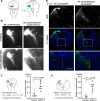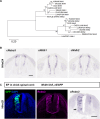A global gene regulatory program and its region-specific regulator partition neurons into commissural and ipsilateral projection types
- PMID: 38781326
- PMCID: PMC11114196
- DOI: 10.1126/sciadv.adk2149
A global gene regulatory program and its region-specific regulator partition neurons into commissural and ipsilateral projection types
Abstract
Understanding the genetic programs that drive neuronal diversification into classes and subclasses is key to understand nervous system development. All neurons can be classified into two types: commissural and ipsilateral, based on whether their axons cross the midline or not. However, the gene regulatory program underlying this binary division is poorly understood. We identified a pair of basic helix-loop-helix transcription factors, Nhlh1 and Nhlh2, as a global transcriptional mechanism that controls the laterality of all floor plate-crossing commissural axons in mice. Mechanistically, Nhlh1/2 play an essential role in the expression of Robo3, the key guidance molecule for commissural axon projections. This genetic program appears to be evolutionarily conserved in chick. We further discovered that Isl1, primarily expressed in ipsilateral neurons within neural tubes, negatively regulates the Robo3 induction by Nhlh1/2. Our findings elucidate a gene regulatory strategy where a conserved global mechanism intersects with neuron class-specific regulators to control the partitioning of neurons based on axon laterality.
Figures








References
-
- Chedotal A., Development and plasticity of commissural circuits: From locomotion to brain repair. Trends Neurosci. 37, 551–562 (2014). - PubMed
-
- Osseward P. J. II, Amin N. D., Moore J. D., Temple B. A., Barriga B. K., Bachmann L. C., Beltran F. Jr., Gullo M., Clark R. C., Driscoll S. P., Pfaff S. L., Hayashi M., Conserved genetic signatures parcellate cardinal spinal neuron classes into local and projection subsets. Science 372, 385–393 (2021). - PMC - PubMed
MeSH terms
Substances
LinkOut - more resources
Full Text Sources
Molecular Biology Databases
Research Materials

